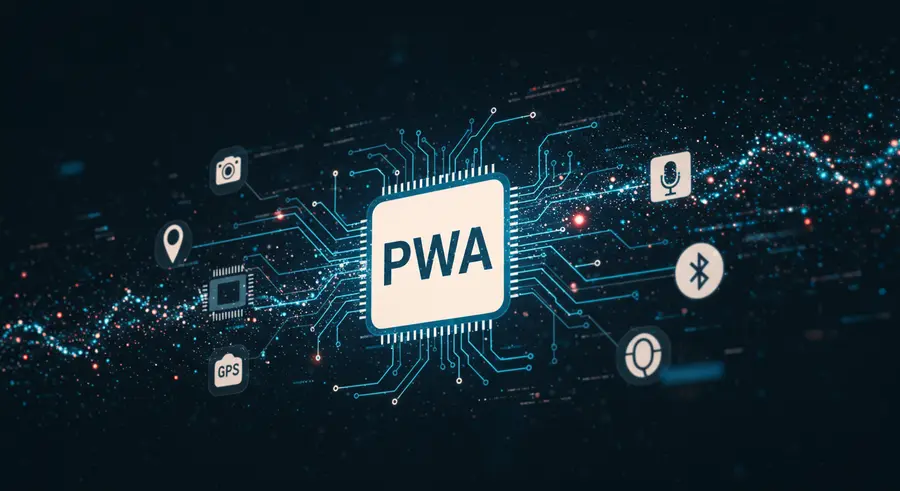Appearance

Welcome, fellow innovators and web enthusiasts! 👋 Today, we're diving deep into an electrifying synergy that's set to redefine the boundaries of web applications: the powerful combination of Progressive Web Apps (PWAs), Artificial Intelligence (AI), and Advanced Hardware Access. Forget what you thought you knew about web limitations – the future is intelligent, integrated, and incredibly interactive!
If you're curious about the foundational power of PWAs, make sure to check out our essential guide: The Power of Progressive Web Apps (PWAs).
🚀 The Evolution of Web Experiences
For years, a perceived chasm separated web applications from their native counterparts, particularly concerning deep device integration. Native apps reigned supreme with their seamless access to a device's hardware like cameras, microphones, GPS, and more. But PWAs have been steadily bridging this gap, and with the advent of advanced Web APIs and the transformative power of AI, that gap is rapidly closing!
🧠 How AI Supercharges PWA Capabilities
AI isn't just about chatbots and recommendations anymore. When woven into the fabric of a PWA, AI can unlock unprecedented levels of personalization, efficiency, and intelligence, especially when combined with hardware access.
- Intelligent Personalization: Imagine a PWA that uses AI to analyze your usage patterns, location (via GPS), and even your environment (via microphone or light sensors) to deliver a truly bespoke experience. Think of an e-commerce PWA that dynamically adjusts its interface and product recommendations based on whether you're indoors or outdoors, or a fitness PWA that suggests workouts tailored to your current energy levels detected through wearable data.
- Contextual Awareness: AI allows PWAs to understand context. A PWA could use AI to process real-time sensor data (accelerometer, gyroscope) to determine if a user is walking, running, or driving, and then adapt its functionality accordingly. For instance, a navigation PWA could proactively offer parking suggestions when it detects you're slowing down in a commercial area.
- Enhanced Media Processing: Leveraging the device's camera and microphone, AI can enable powerful on-device processing within a PWA. Consider:
- Real-time Image Recognition: An AI-powered PWA that identifies objects through your camera feed, whether for a shopping assistant, a plant identifier, or a language translator that reads text from images.
- Voice Commands & Transcription: A PWA that accurately transcribes spoken notes using the microphone, or responds to complex voice commands, improving accessibility and hands-free operation.
🔌 Deep Dive into Hardware Access with Web APIs
Modern Web APIs are the unsung heroes enabling PWAs to tap into device hardware. Here are a few key examples and how AI can elevate their utility:
Geolocation API: Accesses GPS data.
- AI Enhancement: AI can analyze location history, common routes, and even real-time traffic data to predict user needs. For example, a PWA for smart home control could use AI to automatically adjust thermostat settings based on your predicted arrival time, learned from your typical commute via geolocation.
Media Devices API (
getUserMedia): Grants access to camera and microphone.- AI Enhancement: This is where AI truly shines.
- Computer Vision: An AI model within your PWA can analyze camera input for facial recognition (e.g., secure login), object detection, or augmented reality overlays.
- Speech-to-Text & Natural Language Processing (NLP): AI can process microphone input to transcribe speech, understand voice commands, or even perform real-time language translation.
- AI Enhancement: This is where AI truly shines.
Sensors API (Accelerometer, Gyroscope, Magnetometer, Ambient Light Sensor): Provides access to motion and environmental data.
- AI Enhancement: AI can interpret complex sensor data patterns to infer user activity or environmental conditions. A health PWA could use AI to distinguish between different types of exercises based on accelerometer data, or a reading PWA could adjust screen brightness based on ambient light, enhancing eye comfort.
Web Bluetooth & Web NFC APIs: Enable communication with Bluetooth and Near Field Communication devices.
- AI Enhancement: AI can manage and optimize interactions with external devices. Imagine an industrial PWA that uses AI to monitor sensor data from Bluetooth-connected machinery, predicting maintenance needs based on anomalies in the data. Or a retail PWA that uses NFC to provide personalized product information when you tap your phone on an intelligent tag, with AI suggesting related items based on your interaction.
Vibration API: Controls the device's vibration.
- AI Enhancement: While simple, AI can create nuanced haptic feedback. A gaming PWA could use AI to generate dynamic vibration patterns that correspond to in-game events, providing a more immersive experience.
🌟 The Future is Intelligent and Integrated
The convergence of PWAs, AI, and advanced hardware access is not just a trend; it's the next frontier in web development. It empowers developers to build applications that are:
- More Responsive: Adapting dynamically to user needs and environments.
- More Engaging: Offering native-like interactions and immersive experiences.
- More Intelligent: Learning from user behavior and providing proactive assistance.
- More Accessible: Leveraging voice, vision, and contextual cues for diverse users.
As browsers continue to evolve and new Web APIs emerge, the capabilities of PWAs will only expand, making them an increasingly compelling choice for delivering cutting-edge, AI-enhanced, and deeply integrated web experiences. The line between web and native will continue to blur, ushering in an exciting era for users and developers alike!
Stay curious, keep building, and embrace the intelligent web! ✨